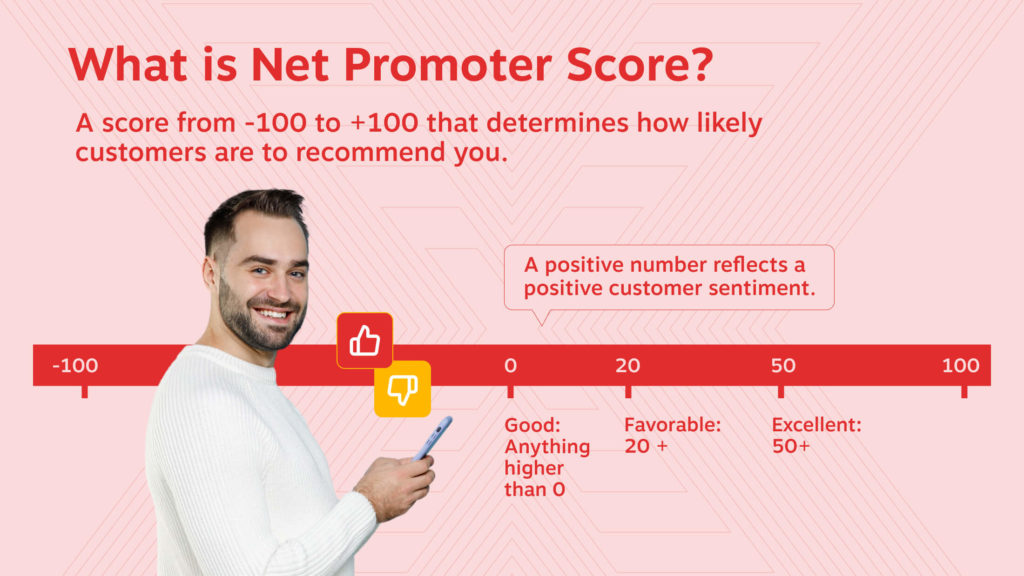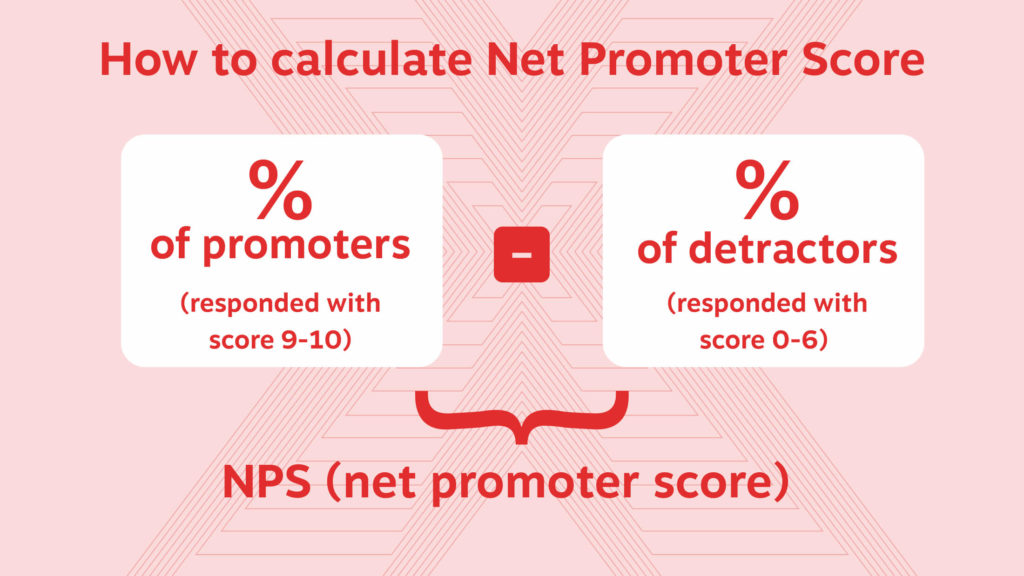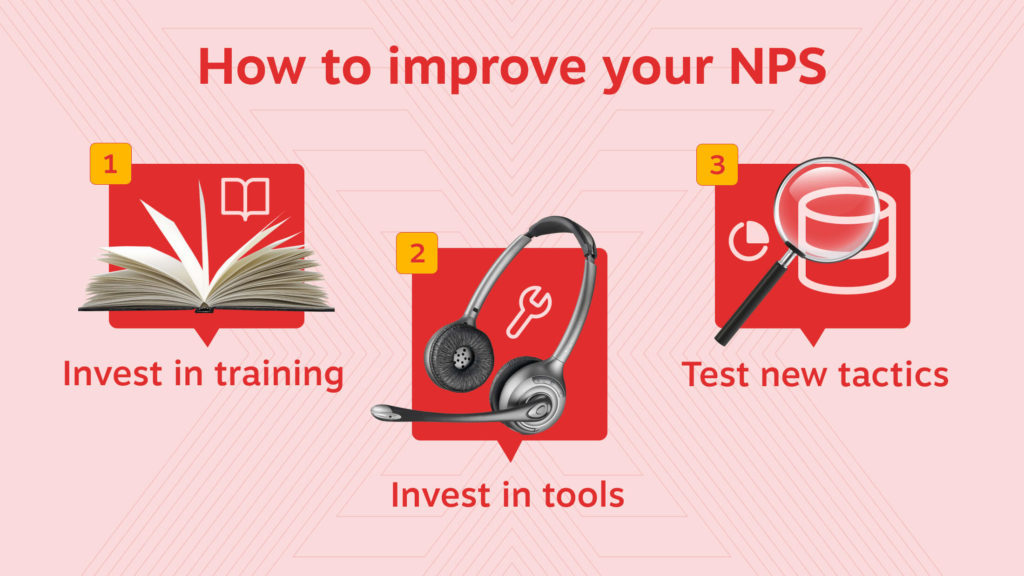What is Net Promoter Score?
Table of Contents

When it comes to tracking how well your company is performing, little compares to Net Promoter Score (NPS).
It’s quite literally feedback from your customers suggesting how much they enjoy being a customer.
For some, NPS is just another figure on a dashboard.
But for the companies invested in continuous performance, it’s the golden KPI that outshines everything else.
Using NPS, giant companies like Tesla and Apple are constantly improving and putting distance between themselves and their competition.
But what if you’re not using NPS today?
Don’t worry.
Because, in this post, we cover the following:
- What is Net Promoter Score?
- What is the Net Promoter Score formula?
- Why is Net Promoter Score important?
- What companies have the best NPS?
- How to improve your NPS
- How Nextiva can help improve your NPS
What is Net Promoter Score?
Net Promoter Score, often shortened to NPS, is a calculation used to determine how likely customers are to recommend your service. Net Promoter Score ranges from -100 to +100 and is often called the ‘gold standard customer experience metric.’

Businesses use NPS to measure how well their company, product, or service is performing throughout the course of different time periods.
A better or worse NPS than the previous period shows whether a business is more or less likely to receive a referral from a customer.
To calculate NPS, businesses use a survey approach to gain responses to a single question. You can opt to ask extra questions to find out why customers score you a certain way and what you could do to improve.
The core NPS question is:
How likely are you to recommend our company to a friend or colleague?
Respondents can score from 0 to 10.
0 means “not at all likely” and 10 means “extremely likely”.
Taking the results from the main question, you total the number of responses, apply the NPS formula, and arrive at a final score.
It’s this simple, single-question approach that businesses love about NPS.
Goran Luledzija, CEO of Localizely, says that feedback is important but so is not taking up too much customer time.
“NPS is so helpful for us because customers can fill it in quickly. There is a higher chance of completion as it is so simple. If they want to leave more detailed feedback, they can. If not, we have an NPS in seconds.”
What is the Net Promoter Score formula?
To calculate your Net Promoter Score, you must tally up all your responses then subtract the percentage of “detractors” from the “promoters”.
A detractor is someone who responds with a score of 0-6.
A promoter is someone who responds with a score of 9 or 10.
You can classify people who respond with 7 or 8 as “passive”. These are neither detractors or promoters and their scores don’t provide any weight to the overall score.

For example, if 50% of respondents score your business a 9 or 10 and 20% score between 0 and 6, you must subtract 20 from 50.
50 – 20 = 30
In this case, your NPS is 30.
But is that a good NPS?
What is a good Net Promoter Score?
We can split NPS into Bad, Good, Favorable, Excellent, and World Class. These are the categories that Bain & Co, the consulting firm credited with introducing NPS, has set.
Good: Anything over 0 is classified as good. A positive number reflects a positive customer sentiment.
Favorable: Anything over 20 is classified as favorable.
Excellent: Anything over 50 is classified as excellent.
World Class: Anything over 80 is classified as world class. This shows that you are in an elite tier of customer service providers, which few companies obtain.
While these are good indicators of general customer experience, there are variables like technology, industry, and geography in play.
The table below shows the dramatic range between the healthcare and telecommunications sector. Use these NPS scores for benchmarking your customer service operation.

While reasons for NPS aren’t always collected or publicized, it’s easy to see why there is such a gap.
When receiving healthcare services, people are happy to be made healthier again. Whereas, telecommunication providers often send an NPS survey after a customer experiences an outage or fault.
Even if the particular interaction is positive, there was a problem that caused the interaction in the first place.
Since people score NPS, we must also factor in moods and motivation. If customers get offered an incentive to complete an NPS survey, they are more likely to provide a positive score.
For an accurate score, remain neutral and ask for an honest opinion.
What is a bad NPS score?
Bain & Co classifies any NPS under 0 as Bad. Both in terms of score and reflection on your company.
A score below 0 shows a clear gap for improvement. Businesses must act to improve their customer experience to remain successful.
In some cases, a single improvement can trigger a better NPS.
For example, if your service goes down twice a week, fixing the uptime will make your customers happier. If everyone changes their score, your NPS shoots up considerably.
What is the highest and lowest possible NPS?
The highest possible NPS is 100. The lowest possible NPS is -100.
If every single customer scores you 9/10 or 10/10, they are all promoters. This shows 100% of your customers are happy to recommend you.
If every single customer scores you between 0 and 6, they are all detractors. This shows the likelihood of referral is low.
While 6/10 reflects an above-average score in other walks of life, only just above average doesn’t mean customers will refer you. As humans, we must be impressed (not just satisfied) to refer our friends or colleagues.
It’s the companies who understand this that succeed with NPS and customer experience.
Why is Net Promoter Score important?
There is no metric more important than what your customers think about you.
Sure, sales figures are important for getting customers through the door.
But customer retention means every new customer is a bonus. It’s not a virtuous circle where a new customer comes in but you lose an old one.
How does NPS affect a company?
When you have a great NPS score, it’s something to shout about.
You can use it as social proof when it comes to marketing your business.
If customers are literally saying “I’m extremely likely to recommend your company”, it’s a positive sign for potential customers.
If, however, you have a bad NPS, you lack the social proof and are constantly fighting for customer retention rather than growing your business through new sales.
When you survey NPS, it gives you the insight to improve your customer’s experience and increase the chance of them referring a friend or colleague.
In publicly traded companies, a good or bad NPS can impact stock price. Likewise, when a company gets purchased, NPS may play a factor in the sale price.
Is there a disadvantage to using NPS?
The slight downside to using NPS is that customers often only recall their latest interaction with a business.
For example, Amna might call technical support three times a year and have two great experiences. But, if the third call ends in a negative experience, Amna is likely to suggest she will refer the company to a friend or colleague.
You can do little to combat this potential problem.
The best advice is to focus on providing a consistent customer experience and the positives will outweigh the negatives.
What companies have the best NPS?
Below are some examples of companies with the highest reported Net Promoter Scores.
Note that some companies choose not to make their NPS public. Some of these scores are estimates based on analysis and interpretation.
According to Customer Gauge, Tesla has an NPS of 97.
This is a reflection of both the automotive industry (average 58) and Tesla’s exceptional customer experience.
Experts put Tesla’s high NPS down to six key criteria:
- Excellent product.
- Transparency.
- Responding to customer feedback.
- Clear CEO communications.
- Personalized buying experience.
- A clear vision.
If you’re reviewing your NPS, it’s worth writing these on a sticky note to remind you of how Tesla succeeds.
It’s not just huge, billion-dollar companies that can achieve high NPS.
Shaunak Amin, CEO of SnackMagic, is proud of their company’s NPS of 90.
“This gold standard metric helps us better understand customer perception so we can gauge their loyalty. With this information, we can identify groups of clients with the potential for significant long-term gains. Then we develop custom strategies for each client to ensure their continued satisfaction which will keep them referring more business our way.”
Hartman Income REIT, a commercial real estate firm in Texas, reports an NPS of 69.3, putting it 30% higher than its industry average.
Sarah Hoopes, Head of PR, says: “To us, NPS is how we regulate our level of customer service. Our head of property management explains it as a temperature gauge. It tells us how we are doing and how others perceive us. It’s one of the main ways we have kept our standards high and have been able to provide our white glove service to our tenants for over 38 years.”
Other high scorers include Costco (79), Starbucks (77), and USAA (75).
What companies have the worst NPS?
At the other end of the Spectrum, suggestion is that Amazon’s NPS has been -26 and -11 in recent years.
But, to demonstrate the fluctuation and the power of change, Amazon’s most recently reported NPS is 62.
Amazon has always shouted about its customer loyalty. But there is suggestion that loyalty doesn’t always reflect the likelihood to refer.
According to Customer Guru, Viacom’s NPS is -23 and Facebook’s is -21.
These three companies make up some of the 250 largest companies in the world. A clear reflection that there is no correlation between company size and NPS.
How to improve your NPS

You can improve your NPS by applying the three Ts.
These are training, tools, and tactics.
1. Training
Continuous training and excellent customer service go hand-in-hand.
It’s one thing getting a new agent up to speed on customer service best practices when they start, but what happens over time?
Agents pick up bad habits, learn to shortcut important steps, and become demotivated when customers have a bad experience.
Support your agents by providing learning materials, refresher sessions, and introducing gamification techniques to keep morale high.
Happy employees lead to happy customers and a higher NPS.
As your product or service evolves, don’t forget to invest in training your support agents on how it works and the nuances it faces.
Empowering agents to serve every customer reduces the chances of needing to transfer a call or live chat.
2. Tools
When it’s impossible to cross-skill agents completely, there are many contact center features that ensure customers get to the right agent first time.
For example, skills-based routing allows callers to select the reason they are calling and get transferred to an agent with the appropriate experience.
So when a customer selects option 2 for help with their broadband, you know the agent handling the call has experience with broadband.
There are no more long hold times or transfers between agents.
Another tool option is implementing a call back option during long wait times. This is the super helpful feature that lets callers select “please call me back” instead of waiting for an extended period of time.
How does this impact NPS? This type of feature improves your first call resolution, and inturn, your NPS. After all, nobody wants to be bumped from department to department and have to explain their problem over and over again. Likewise, nobody wants to wait in a queue while their problem gets worse and worse. Tools that decrease their wait time can certainly impact the NPS.
You may also like: Advanced IVR: Reducing Abandoned Calls
3. Tactics
When you empower your agents with the right training and tools, you stand a chance of improving your NPS.
But a conscious effort to apply better tactics will take this to another level.
Start by conducting a call center SWOT analysis to uncover your strengths, weaknesses, opportunities, and threats.
Here’s an example of what that might look like:
| Strengths: Large, growing team Core product knowledge Increased training budget |
Weaknesses: Handle times continue to rise Training resources are overwhelmed Had to defer call control training Lack of a business continuity plan |
| Opportunities: Train senior staff to become coaches Revamp career progression plan Workforce training grant awarded |
Threats: Competitors gaining market share Phone system setup slows down onboarding Closest rival using semi-automated call center technology |
When you’ve compiled the results of your analysis, you can start to plan for changes in your department.
How Nextiva can help improve your NPS
Nextiva provides contact center technology to help improve your customer’s experience.
Whether you need to introduce multichannel functionality or reduce call times, you’ll find a wealth of features that translate to customer benefits.
While we can’t enforce training or tactics, we can help by providing a powerful set of tools to get the job done.
If you’re unhappy with your NPS, talk to a Nextiva expert about how our tools can help.







